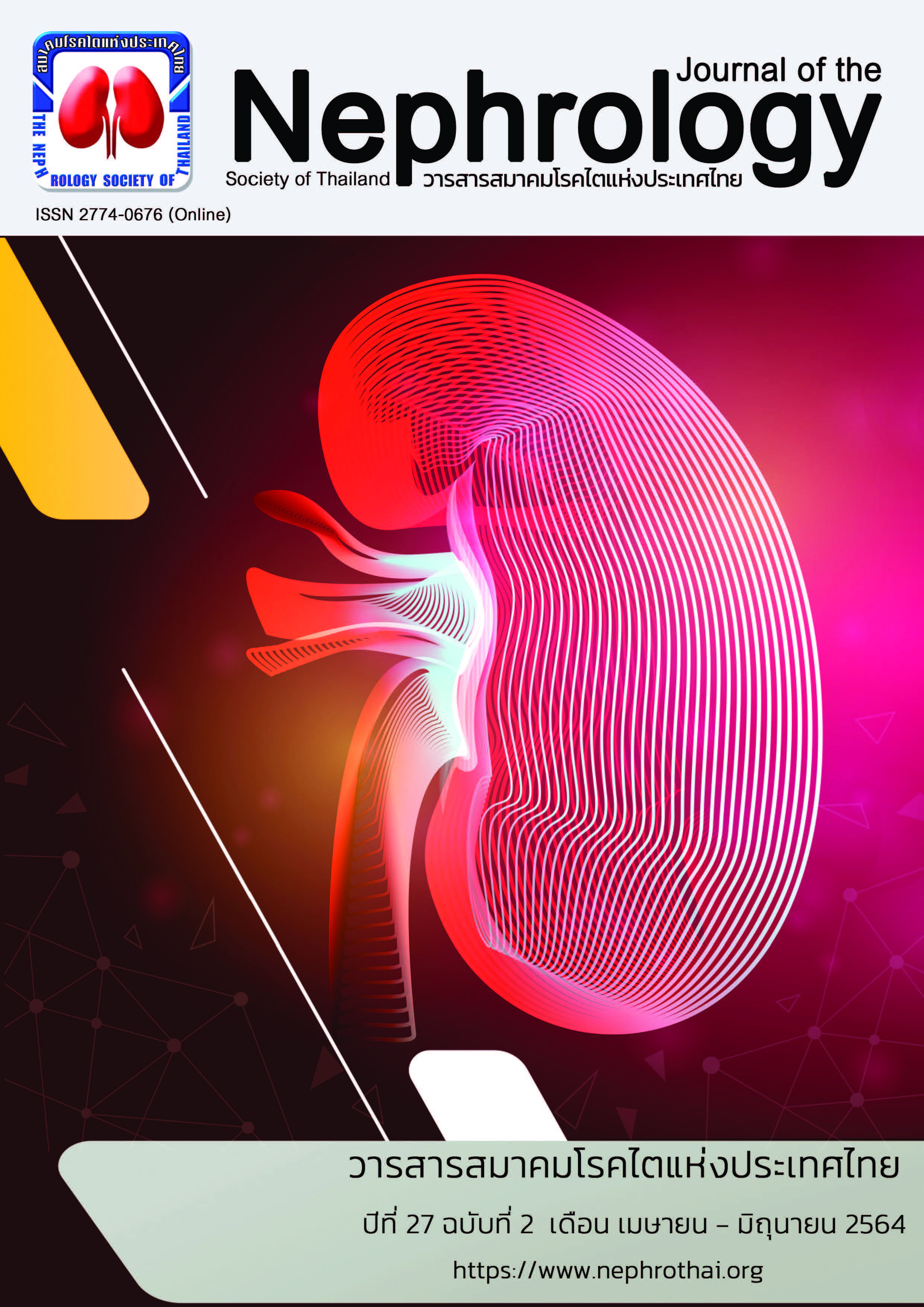Role of extracorporeal removal of free light chain in myeloma cast nephropathy
Main Article Content
Abstract
Myeloma cast nephropathy (MCN) is the most common renal pathology among patients with multiple myeloma and severe kidney injury, characterized by precipitation of free light chain immunoglobulins in distal renal tubules, leading to obstruction, tubulointerstitial inflammation, and fibrosis. From related studies, improved renal function among patients with myeloma cast nephropathy directly correlated with reduced serum free light chain levels. Moreover, suppressing light chain production using chemotherapy, which is the current standard of care, and rapidly reducing circulating monoclonal light chains using extracorporeal methods have been recently developed to prevent free light chain precipitation in renal tubules and tubular injury. The effectiveness of reducing free light chains using extracorporeal free light chain removal combined with chemotherapy among patients with myeloma cast nephropathy has been established, but benefits in renal recovery after treatment remain doubtful due to study limitations. Additionally, several factors could interfere with the study outcomes, particularly the difference in chemotherapy responsiveness in the study population an important factor to determine renal outcome among patients with myeloma cast nephropathy. Nevertheless, further well-designed clinical studies to determine the benefit of using extracorporeal free light chain removal combined with a standard regimen of chemotherapy among patients with myeloma cast nephropathy are still required.
Article Details

This work is licensed under a Creative Commons Attribution-NonCommercial-NoDerivatives 4.0 International License.
This article is published under CC BY-NC-ND 4.0 license, which allows for non-commercial reuse of the published paper as long as the published paper is fully attributed. Anyone can share (copy and redistribute) the material in any medium or format without having to ask permission from the author or the Nephrology Society of Thailand.
References
Multiple myeloma: 2018 update on diagnosis, risk-stratification, and management. Am J Hematol 2018;93:981-1114.
Nasr SH, Valeri AM, Sethi S, Fidler ME, Cornell LD, Gertz MA, et al. Clinicopathologic correlations in multiple myeloma: a case series of 190 patients with kidney biopsies. Am J Kidney Dis 2012;59:786-94.
Lusco MA, Fogo AB, Najafian B, Alpers CE. AJKD Atlas of Renal Pathology: Light Chain Cast Nephropathy. Am J Kidney Dis 2016;67:e17-8.
Korbet SM, Schwartz MM. Multiple myeloma. J Am Soc Nephrol 2006;17:2533-45.
Herrera GA, Joseph L, Gu X, Hough A, Barlogie B. Renal patho logic spectrum in an autopsy series of patients with plasma cell dyscrasia. Arch Pathol Lab Med 2004;128:875-9.
Montseny JJ, Kleinknecht D, Meyrier A, Vanhille P, Simon P, Pruna A, et al. Long-term outcome according to renal histological lesions in 118 patients with monoclonal gammopathies. Nephrol Dial Transplant 1998;13:1438-45.
Basnayake K, Stringer SJ, Hutchison CA, Cockwell P. The biology of immunoglobulin free light chains and kidney injury. Kidney Int 2011;79:1289-301.
Hutchison CA, Harding S, Hewins P, Mead GP, Townsend J, Bradwell AR, et al. Quantitative assessment of serum and urinary polyclonal free light chains in patients with chronic kidney disease. Clin J Am Soc Nephrol 2008;3:1684-90.
Hutchison CA, Cockwell P, Stringer S, Bradwell A, Cook M, Gertz MA, et al. Early reduction of serum-free light chains associates with renal recovery in myeloma kidney. J Am Soc Nephrol 2011;22:1129-36.
Hutchison CA, Heyne N, Airia P, Schindler R, Zickler D, Cook M, et al. Immunoglobulin free light chain levels and recovery from myeloma kidney on treatment with chemotherapy and high cut-off haemodialysis. Nephrol Dial Transplant 2012;27:3823-8.
Clark WF, Stewart AK, Rock GA, Sternbach M, Sutton DM, Bar rett BJ, et al. Plasma exchange when myeloma presents as acute renal failure: a randomized, controlled trial. Ann Intern Med 2005;143:777-84.
Zucchelli P, Pasquali S, Cagnoli L, Ferrari G. Controlled plasma exchange trial in acute renal failure due to multiple myeloma. Kidney Int 1988;33:1175-80.
Johnson WJ, Kyle RA, Pineda AA, O’Brien PC, Holley KE. Treatment of renal failure associated with multiple myeloma. Plasmapheresis, hemodialysis, and chemotherapy. Arch Intern Med 1990;150:863-9.
Padmanabhan A, Connelly-Smith L, Aqui N, Balogun RA, Klingel R, Meyer E, et al. Guidelines on the Use of Therapeutic Apher esis in Clinical Practice - Evidence-Based Approach from the Writing Committee of the American Society for Apheresis: The Eighth Special Issue. J Clin Apher 2019;34:171-354.
Leung N, Gertz MA, Zeldenrust SR, Rajkumar SV, Dispenzieri A, Fervenza FC, et al. Improvement of cast nephropathy with plasma exchange depends on the diagnosis and on reduction of serum free light chains. Kidney Int 2008;73:1282-8.
Ward RA. Protein-leaking membranes for hemodialysis: a new class of membranes in search of an application? J Am Soc Nephrol 2005;16:2421-30.
Gondouin B, Hutchison CA. High cut-off dialysis membranes: current uses and future potential. Adv Chronic Kidney Dis 2011;18:180-7.
Hutchison CA, Cockwell P, Reid S, Chandler K, Mead GP, Harrison J, et al. Efficient removal of immunoglobulin free light chains by hemodialysis for multiple myeloma: in vitro and in vivo studies. J Am Soc Nephrol 2007;18:886-95.
Hutchison CA, Harding S, Mead G, Goehl H, Storr M, Bradwell A, et al. Serum free-light chain removal by high cutoff hemodialysis: optimizing removal and supportive care. Artif Organs 2008;32:910-7.
Hutchison CA, Cockwell P, Moroz V, Bradwell AR, Fifer L, Gillmore JD, et al. High cutoff versus high-flux haemodialysis for myeloma cast nephropathy in patients receiving bortezo mib-based chemotherapy (EuLITE): a phase 2 randomised controlled trial. Lancet Haematol 2019;6:e217-e28.
Bridoux F, Carron PL, Pegourie B, Alamartine E, Augeul-Meunier K, Karras A, et al. Effect of High-Cutoff Hemodialysis vs Conventional Hemodialysis on Hemodialysis Independence Among Patients With Myeloma Cast Nephropathy: A Randomized Clinical Trial. JAMA 2017;318:2099-110.


